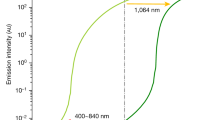Abstract
In this paper we describe the use of thermo-activated PNIPAM nano-material in optical switching devices. In other publications, the PNIPAM is used either as a carrier for crystalline colloidal array self-assemblies or as micro-particles that serve as pigment bags. In this publication we use a simpler-to-fabricate pure PNIPAM solution in a semi-dilute regime. The PNIPAM devices produced are transparent at temperatures below a critical temperature of 32°C and become diffusing above this temperature. We show that at 632 nm the transmission through the devices is about 75% in the transparent state while the additional attenuation achieved in the diffusing state is of the order of 38 dB. The experimental fall and rise times obtained are large (about 300 ms and 5 s, respectively) due to the non-optimised thermal addressing scheme. In addition, spectral measurements taken in the infrared spectrum (700–1,000 nm) demonstrate that the cell response is flat over a large portion of the infrared spectrum in both the transparent and the diffusing states.





Similar content being viewed by others
References
Akashi R, Tsutsui H, Komura A (2002) Polymer gel light-modulation materials imitating pigment cells. Adv Mater 14:1808–1811
Asher SA, Weissman JM, Sunkara HB (2000) Thermally switchable optical devices. US patent 6094273
Bokias G, Durand A, Hourdet D (1998) Molar mass control of poly(N-isopropylacrylamide) and poly(acrylic acid) in aqueous polymerizations initiated by redox initiators based on persulfates. Macromol Chem Phys 199:1387–1392
Dong L, Agarwal1 AK, Beebe DJ, Jiang H (2006) Adaptive liquid microlenses activated by stimuliresponsive hydrogels. Nature 442(7102):551–554
Heskins M, Guillet JE (1968) Solution properties of poly(N-isopropylacrylamide). J Macromol Sci Chem A2:1441–1455
Huber DL, Manginell RP, Samara MA, Kim BI, Bunker BC (2003) Programmed adsorption and release of proteins in a microfluidic device. Science 301:352–354
Katsumoto Y, Tanaka T, Sato H, Ozaki Y (2002) Conformational change of poly(N-isopropylacrylamide) during the coil-globule transition investigated by attenuated total reflection/infrared spectroscopy and density functional theory calculation. J Phys Chem A 106:3429–3435
Kim BY, Kang HS, Kim JD (2002) Thermo-sensitive microparticles of PNIPAM-grafted ethylcellulose by spray-drying method. J Microencapsul 19:661–669
Lopez G, Chilkoti A, Atanassov P, Goparaju V (2002) Stimuli responsive hybrid materials containing molecular actuators and their applications US patent 6491061B1
Reese CE, Mikhonin AV, Kamenjicki M, Tikhonov A, Asher SA (2004) Nanogel nanosecond photonic crystal optical switching. J Am Chem Soc 126:1493–1496
Schild HG (1992) Poly (N-isopropylacrylamide): experiment, theory and application. Prog Polym Sci 17:163–249
Snowden M, Murray M, Chowdry B (1996) Some like it hot Thermo-sensitive polymers. Chem Ind 14:531–534
Sudor J (1997) Electrophoretic separations of polyelectrolytes in free-solutions and sieving media Thesis Chemistry Department, Indiana University, IN, USA
Sudor J, Barbier V, Thirot S, Godfrin D, Hourdet D, Millequant M, Blanchard J, Viovy JL (2001) New block-copolymer thermoassociating matrices for DNA sequencing: effect of molecular structure on rheology and resolution. Electrophoresis 22:720–728
Tanaka T (1978) Collapse of gels and the critical end point. Phys Rev Lett 40:820–823
Tanaka T, Fillmore D, Sun S-T, Nishio I, Swislow G, Shah A (1980) Phase transition in ionic gels. Phys Rev Lett 45:1636–1639
Twaites BR, de las Heras Alarcon C, Cunliffe D, Lavigne M, Pennadam S, Smith JR, Gorecki DC, Alexander C (2004) Thermo and pH responsive polymers as gene delivery vectors: effect of polymer architecture on DNA complexation in vitro. J Control Release 97:551–566
Author information
Authors and Affiliations
Corresponding author
Rights and permissions
About this article
Cite this article
Mias, S., Sudor, J. & Camon, H. PNIPAM: a thermo-activated nano-material for use in optical devices. Microsyst Technol 14, 747–751 (2008). https://doi.org/10.1007/s00542-007-0457-3
Received:
Accepted:
Published:
Issue Date:
DOI: https://doi.org/10.1007/s00542-007-0457-3




